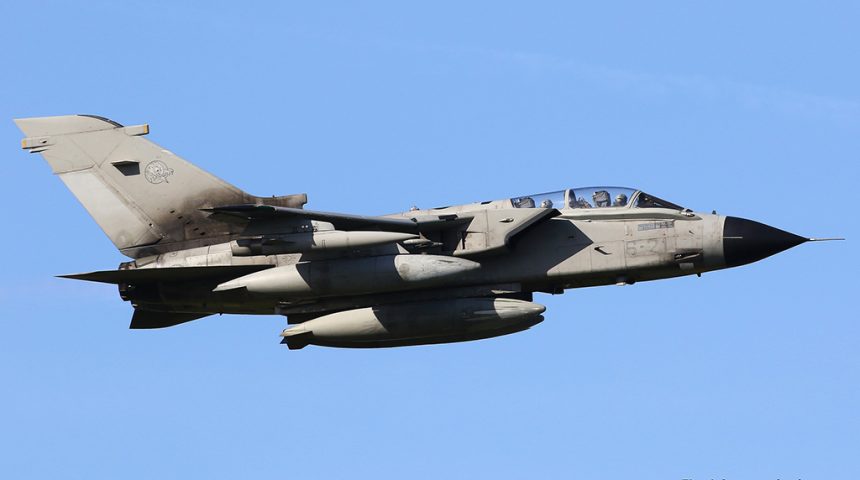Codenamed “Steadfast Noon”, the yearly NATO drills involve both DCA (Dual Capable Aircraft) as well as non-nuclear aircraft.
NATO’s yearly “deterrence” exercise, codenamed “Steadfast Noon”, is currently underway in Europe. The exercise officially started on Oct. 17, 2022, and due to come to an end on Oct. 30, although there should be no flying activities past Friday Oct. 28.
The routine strike exercise is hosted by a different NATO country (or two) each year at air bases where U.S. tactical B61 nuclear bombs are stored. The goal is in fact to train regional NATO allies aircrews in using U.S. tactical nuclear bombs. This year, the exercise was centered at Kleine Brogel Air Base, Belgium, one of the six European airbases that store U.S. nukes, although missions were flown also over the North Sea and the United Kingdom.
There are many reasons why this year’s iteration of Steadfast Noon was worth of remark. First of all, the fact that the exercise (that needless to say does not involve Live weapons) was carried out during the largest conventional war in Europe since WWII and amid growing nuclear tension with Russia over the invasion of Ukraine.
Moreover, unlike the previous years, when the Steadfast Noon lasted just one week, the 2022 edition lasted two weeks. In effect, in the past, Steadfast Noon took place alongside another exercise, dubbed “Cross Servicing” or “X-Servicing”, whose goal was to test the ability of each partner to service other nation’s aircraft at NATO airfield operating on their territory. However, since the Steadfast Noon and X-Servicing involved the same assets on the same bases, it seemed more likely that the real purpose of the X-Servicing exercise was mostly to keep a low profile on a nuclear exercise that could cause political controversy in some countries. “Actually, it looks like that X-Servicing or any other exercises preceding or coinciding with the Steadfast Noons are somehow used to disguise the main one considered the political sensitivity of the nuclear mission in many NATO countries,” we commented last year.
Indeed, the situation in Europe has considerably changed, and this might be the reason why this year there was (probably) no need to hide a nuclear exercise, given the current, unprecedented fears of a nuclear war in the Old Continent.
Anyway, the 2022 edition of Steadfast Noon involved 14 countries and up to 60 aircraft of various types, including fourth and fifth generation fighter jets, as well as surveillance and tanker aircraft. As in previous years, U.S. B-52 strategic bombers took part in the drills flying round-trip missions from Minot Air Force Base, North Dakota.
Two types of assets take part in the nuclear exercise: DCA (Dual Capable Aircraft) – aircraft from Belgium, Germany, Italy, the Netherlands, Turkey and the U.S. that are able to perform either conventional or theater nuclear missions carrying the B61 bomb – and non-nuclear aircraft that support the mission under the SNOWCAT (Support of Nuclear Operations With Conventional Air Tactics) program, which is used to enable military assets from non-nuclear countries to support the nuclear strike mission without being formally part of it.
Among the DCA there were also the Italian Tornado IDS of the 154° Gruppo (Squadron) of the 6° Stormo (Wing) from Ghedi Air Base. Three “Tonkas” (as the Tornados are often nicknamed) deployed to Volkel in the Netherlands, where they arrived between Oct. 17 and 19. In the afternoon on Oct. 19, the Tornados, using callsign “Devil” flew their first Steadfast Noon missions. Our contributor Edwin Schimmel went there and took the photos of the Italian A-200Cs (this is the designation of the Tornado IDS in accordance with the Italian MOD mission design series) that you can find in this story.

Several missions could be tracked online, including those of the Italian Tornados that carried out several attacks on simulated targets located along the British eastern coast.
This crazy loud and fast unidentified military jet just flew over my neighbourhood and has already passed the coastline, seemingly heading back to its base in The Netherlands.
Callsign “DEVIL61” is very fitting given how loud it was, good lord, I wonder what type of jet it is. pic.twitter.com/Xh4OEhbBG3
— Rin | 凛 (@TheIshikawaRin) October 26, 2022
Once again, flight tracking websites provided front-row seats at Steadfast Noon.
Good bit of strategic traffic this morning above the skies of Europe as NATO exercise STEADFAST NOON gets underway… pic.twitter.com/EbpuNKvfpz
— The Intel Crab 🇺🇦 (@IntelCrab) October 19, 2022
Enough tracks today for the nuclear strike ”Steadfast Noon” participation 😆
About ⬛️six tankers, 🟦 NATO E3 support, various 🟥 fighters (and assuming a whole lot more non mode-S flights) from different NATO countries 🇳🇱🇧🇪🇬🇧🇩🇪🇮🇹🇵🇱🇪🇺 pic.twitter.com/f4BnPQS6Ur
— Danny Lemckert 🇳🇱✈ (@DLNetherlands) October 21, 2022
Looks like ongoing NATO nuke exercise Steadfast Noon is gearing up for the day with US B-52 bombers entering European theater.#SteadfastNoon #steadfastnoon https://t.co/yxGNiBA3nw pic.twitter.com/fePLq4oU78
— Hans Kristensen (@nukestrat) October 21, 2022
Noteworthy, taking part in Steadfast Noon this year were also U.S. Air Force F-22 Raptors assigned to the 90th Expeditionary Fighter Squadron and deployed to Leeuwarden, in the Netherlands, that alongside the U.S. Air Force F-35A Lightning IIs, and F-15E Strike Eagles integrated and trained together with Royal Netherlands Air Force F-35A Lightning IIs.
Photos of U.S. Air Force (🇺🇸) F-22 Raptors taking off from Leeuwarden AB, the Netherlands (🇳🇱) for a training flight in support of Exercise Steadfast Noon last week. pic.twitter.com/vK6O9kqA28
— Aerospace Intelligence (@space_osint) October 27, 2022









